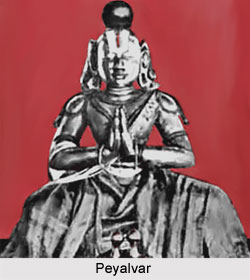 Peyalvar or Peyalwar, also known as Pey Azhwar, was a prominent Vaishnava poet saint who lived during the 7th Century AD. He was one of the 12 Alvar saints from South India, who are recognised for their involvement with the Vaishnava tradition of Hinduism. The temples revered by the hymns and verses of the Alvars or Azhwars were termed as Divya Desam. Peyalvar wrote the literary work of Moondraam Thiruvandaadhi (Moondhram Thiruvandhadhi) that consists of one hundred paasurams or verses which are incorporated in the Nalayira Divya Prabandham, also known as Divya Prabandham. Nalayira Divya Prabandham is an anthology of 4,000 verses in Tamil, written by the twelve Alvars prior to 8th century AD. The collection of poems was compiled by Nathamuni between the 9th Century- 10th Centuries. Peyalvar was a follower of the Vaishnava Bhakti philosophy.
Peyalvar or Peyalwar, also known as Pey Azhwar, was a prominent Vaishnava poet saint who lived during the 7th Century AD. He was one of the 12 Alvar saints from South India, who are recognised for their involvement with the Vaishnava tradition of Hinduism. The temples revered by the hymns and verses of the Alvars or Azhwars were termed as Divya Desam. Peyalvar wrote the literary work of Moondraam Thiruvandaadhi (Moondhram Thiruvandhadhi) that consists of one hundred paasurams or verses which are incorporated in the Nalayira Divya Prabandham, also known as Divya Prabandham. Nalayira Divya Prabandham is an anthology of 4,000 verses in Tamil, written by the twelve Alvars prior to 8th century AD. The collection of poems was compiled by Nathamuni between the 9th Century- 10th Centuries. Peyalvar was a follower of the Vaishnava Bhakti philosophy.
Early Life of Peyalvar
The poet saint Peyalvar (Pey Azhwar) was born in the region of Tirumayilai, (now known as Mylapore and included as a part of Chennai city) during the 7th century AD. According to legends, Peyalvar was found as a baby on a lily flower close in a pond near a temple of Adi Kesava Perumal located in Mylapore. As per the followers of Vaishnavism, the Alvar saint is widely regarded as the incarnation of the divine sword of Lord Vishnu, known as Nandakam.
Compositions of Peyalvar
Peyalvar has written several striking Paasurams or hymns devoted Lord Vishnu in his devotional Tamil literary work of Moondraam Thiruvandaadhi or Moondhram Thiruvandhadhi. The work is included as one of the poetic compositions in the anthology Nalayira Divya Prabandham (Divya Prabandham). The one hundred hymns composed by the saint poet comprises of the third 100 portion of the Divya Prabhandham collection. The hymns of Peyalvar in Moondraam Thiruvandaadhi initiate with the words Tiruk Kanden, Pon Meni Kanden, which depicts that the Alvar mendicant saint has discovered the glorious and magnificent appearance of Lord Vishnu and all his incarnations. He has also found the golden form of the Lord.
The hymns in the literary work of Moondraam Thiruvandaadhi composed by Peyalvar narrates that the poet composed the song as it bestowed him with divine awareness and understanding. In his work, Peyalvar describes the glorious vision of the Lord through which the saint has realized that the whole universe comprises the very body of Narayana, a form of Lord Vishnu. The revered Alvar continues to describe all that he has realized and the divine knowledge he has been blessed with. In the Prabandham, Peyalvar narrates that he has dedicated the rest of his life to the service of Lord Vishnu (Perumal). The hymns composed by Peyalvar are formed in the Anthathi style. In this style the final word of the preceding verse is utilised as the initial word in the subsequent hymn.
The Vaishnava poet saint, Peyalvar, composed 100 paasurams or verses for the Divya Prabandham anthology. The hymns of Moondraam Thiruvandaadhi initiate from 2282 paasurams and end at 2381 paasurams of Nalayira Divya Prabandham.













